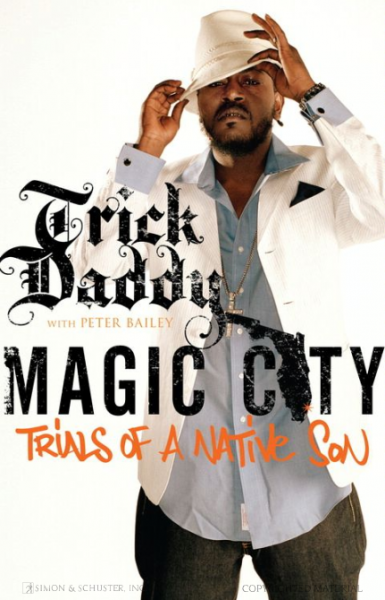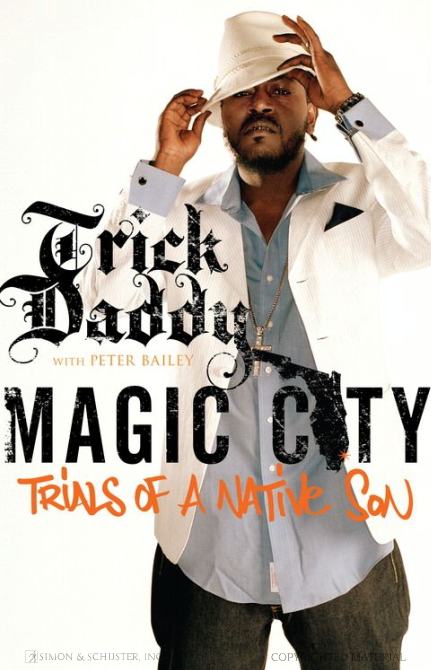
Word on the street is that Trick Daddy’s book Magic City: Trials of A Native Son is a must read! I’m going to have to go cop me a copy and support the 305 Mayor. But in the meantime, with the help of author Peter Bailey, the book hits shelves on November 16 and Trick gave RapFix an exclusive excerpt from the first chapter, “Born A Thug.” Check it out below:
“My life began with Pork-n-Beans.
I’m not talking about the canned food that most residents in Anyhood, USA, have in their cupboards. Not the soppy stuff sitting next to the Kool-Aid and ramen, staples of a diet built on hard knocks.
History cats say the name came about because the only meal residents in Liberty Square Houses could afford was pork-n-beans. The idea isn’t that far-fetched. My family’s cupboard was stocked with the cuisine. But the origins stemmed from the stench that came from a local store that cooked the sloppy mess.
It stunk up the entire projects. Then younger folks coined the name on whatever color your front door was. Apartments with blue doors were called Blueberries. Those with green doors were Green Machine. Mines had maroon doors, called Pork-n-Beans.
It’s a stone’s throw away from downtown Miami, but the Beans might as well be in a foreign country judging by the way cabbies warn visitors to stay away. I’ll admit the place ain’t South Beach. The neighborhood lies to the east of the I‑95 expressway off exit 6A, Martin Luther King Jr. Boulevard. Drivers usually whiz past the wheelchair-bound beggars before they roll up to their car windows along the exit’s service road. You’d think it’s hard to ignore a dude with two half-legs and a sign that says a penny for my pain, thank you. Abandoned corner stores, vacant lots, and crippled-looking palm trees line Sixty-second Street until Twelfth Parkway, where the projects begin.
I lived at 1238 Northwest Sixty-eighth Street with my mother, Pearl Brockington, my ten brothers and sisters, and whichever boyfriend she had at the time, usually some sorry good-for-nothing milking the free AC.
Yeah, I said ten brothers and sisters. That’s not counting my other twenty or so half siblings on my daddy’s side. He has an unknown number of children, but I’ll get to that later. I was born unceremoniously at Jackson Memorial Hospital on September 27, 1974. There weren’t any cameras or festivities when little Maurice Young popped into the world. As a kid I imagined my father holding my mother’s hand, cheering her through the delivery, kissing her forehead, and whispering things like “Wow, baby, we did it!”—my parents smiling for the camera as a shot is snapped of a bloody, crying infant. Then I snap to. I see a doctor hovering over my mother sighing, nurses in the corner shaking their heads. Just another ghetto child born on the welfare dime waiting to wreak havoc in the projects. Even if those doctors and nurses didn’t say it, I’m sure the thought crossed their minds watching Pearl all strung out, sweat and blood on the delivery table. She was truly a member of the UN even if Ban Ki‑moon didn’t know it.
Uneducated.
Unmarried.
Unemployed.
Society would have to make room for yet another one. Pearl and I were alone. It was just me and my older sister, Tameko. Angela, Zakea, Keyon, Omar, Jhabor, Jermaine, D’Angelo, Tavarus, and Hakeem came later.
With only a seventh-grade education, Pearl turned to what seemed to be her most viable economic option—making babies. From the late 1970s to the early ’80s all a teenage girl had to do was have kids and the government took care of her. In a sad and twisted way, babies were like vouchers that got you housing and other goodies. The welfare system was systematically trapping folks into a cycle of poverty with disregard to rehabbing young mothers like Pearl. She had already suffered a life of abuse and neglect. Having kids with men who didn’t love her just compounded that pain.
Like many folks in the Pork-n-Beans, Pearl’s roots went back to Georgia and the Carolinas. Her immediate family came from a small town in South Carolina, a poor place, the kind that puts a face to the conditions that coined the term “dirty” South. Pearl, alongside her siblings, aunts, and uncles, lived on several acres of land scattered over a five-mile radius. Her father was a typical Southerner of the newly freed generation of blacks. To this day my granddaddy speaks with an obvious uncertainty of his stock in life. He’s a typical old man from the South. I’ve only met him three times, but he left a lasting impression. It’s like the shackles broken by my great-granddaddy never left my granddaddy’s wrists. Nevertheless, he tried his hardest to turn sour lemons into sweet lemonade. But he couldn’t stop the abuse my mother would suffer in that small town.
My relatives lived close together so that they could depend on one another for the day-to-day. A couple of my great-uncles reaped the spoils of living in such close quarters. Those spoils were tender young girls to molest. Pearl never spoke much about the abuse, but it left her scarred.
When the family arrived in Miami, the plan was to gain a foothold in new soil, but they soon found themselves stuck in the same rut minus the windchill. My granddaddy decided to hell with the South and moved to Rochester, New York, leaving my fifteen-year-old Pearl behind to be raised by one of her
aunts. The racism dealt to them and other blacks was no different from what they faced in Alabama, Mississippi, Georgia, and the Carolinas. Except for a few liquor stores and bodegas, Liberty City had no businesses. Folks had to head to the suburbs to shop.
A couple of high-profile incidents of police brutality only made things worse. People wanted to change the state of the neighborhood, with its broken sewer pipes and deep potholes. So they cleared way for a new city the best way blacks in Miami knew how.
We burned the motherf—er down.”
If you have had a chance to read the book, let us know your thoughts!



